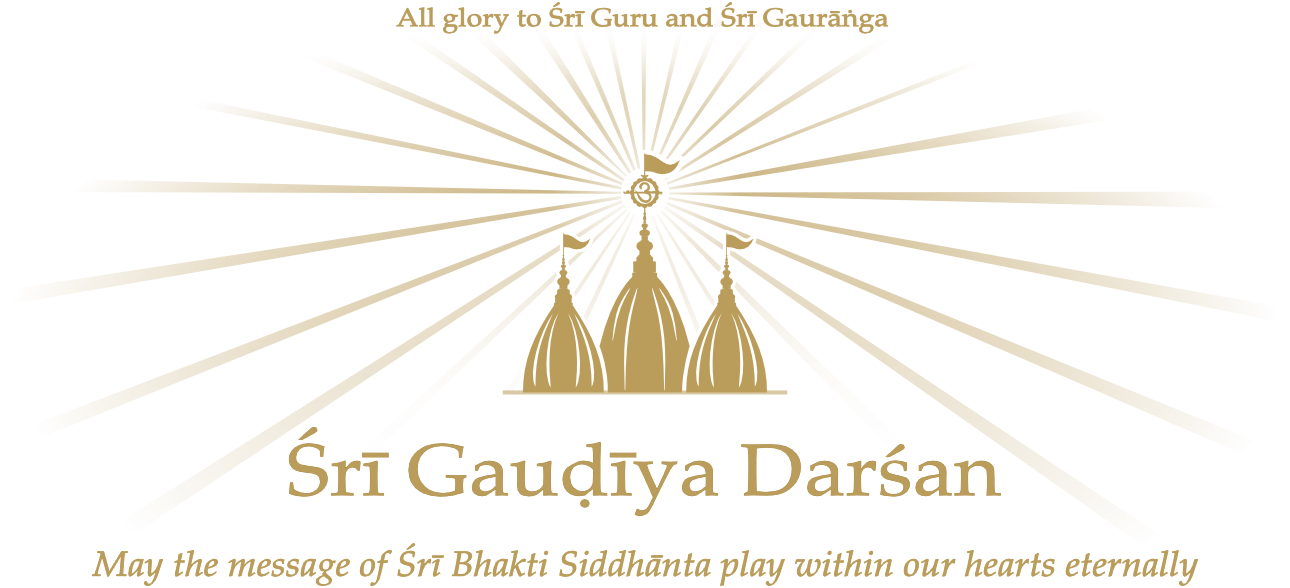Śrīla Bhakti Sundar Govinda Dev-Goswāmī Mahārāj describes the glory of madhura-rasa in Vṛndāvan.
Today is the appearance day of Śrīmatī Rādhārāṇī, who manifested as the daughter of Mahārāj Vṛṣabhānu.
I recall a verse I learned when I started studying poetry as a boy:
jagataḥ pitarau vande pārvatī parameśvarau
As speech and meaning are united, so Rādhā and Kṛṣṇa are united. One cannot be separated from the other. Why? Śakti-śaktimatayor abhedaḥ [“Power and the Powerful are inseparable.”] This teaching is seen throughout the Vedānta-darśan and the Upaniṣads. The fundamental nature of the Lord is that He is Saśakti-śaktimān, the all-powerful with His power. When the word ‘Bhagavān’ [lit. ‘possessor of power’, colloq. ‘God’] is spoken, then the Lord’s Power cannot be separated from Him.
Śrīla Bhakti Vinod Ṭhākur has written:
tad upari śrī-gokula-vṛndāraṇya nāma
We are residing in a brahmaṇḍa, that is, a universe made up of fourteen worlds: seven lower planes and seven upper planes known as Bhūḥ, Bhuvaḥ, Svaḥ, Mahaḥ, Jana, Tapa, and Satya. Innumerable such brahmaṇḍas float in the waters of the Virajā River. Beyond the Virajā River, the highest plane within the spiritual Paravyoma Dhām is Śrī Gokula Vṛndāvan.
What is that abode like? Those of you who have read Brahma-saṁhitā know this verse which describes that abode therein:
lakṣāvṛteṣu surabhīr abhipālayantam
lakṣmī-sahasra-śata-sambhrama-sevyamānaṁ
govindam ādi-puruṣaṁ tam ahaṁ bhajāmi
That abode is beautified by homes made of spiritual gems, millions of wish-fulling trees, and herds of cows. All of these opulences eagerly wait to serve and fulfil the desires of their beloved Lord. The original Lord, Govinda, who is filled with inconceivable qualities, resides in this abode beyond Paravyoma Dhām.
There is a full description of Goloka Vṛndāvan in Brahma-saṁhitā:
drumā bhūmiś chintāmaṇi-gaṇa-mayi toyam amṛtam
kathā gānaṁ nāṭyaṁ gamanam api vaṁśī priya-sakhi
chid-ānandaṁ jyotiḥ param api tad āsvādyam api cha
sa yatra kṣīrābdhiḥ sravati surabhībhyaś cha sumahān
nimeṣārdhākhyo vā vrajati na hi yatrāpi samayaḥ
bhaje śvetadvīpaṁ tam aham iha golokam iti yaṁ
vidantas te santaḥ kṣiti-virala-chārāḥ katipaye
Lakṣmī-sahasra-śata-sambhrama-sevyamānaṁ: Rādhārāṇī fulfils Kṛṣṇa’s desires in all respects in thousands and thousands of forms. We see that She appeared in this world during Kṛṣṇa’s Pastimes in Gokula. The only difference between Goloka and Gokula is that Gokula appears in this world while the Lord’s eternal Pastimes go on in Goloka. The same Pastimes manifest in two forms. We desire to become particles of dust in that land, where the cause of all causes who is the origin of all but has no origin, Govinda, is accompanied by His servants and served in all five rasas. In Goloka Vṛndāvan, the Divine Couple, Rādhā and Kṛṣṇa, are served in all five rasas as Their eternal Pastimes unfold.
In Śrīmad Bhāgavatam, Śrī Chaitanya Mahāprabhu’s sole worshippable Deity is identified, but mention of Śrī Rādhikā is made only in a very covered way.
ramyā kāchid upāsanā vraja-vadhū-vargeṇā yā kalpitā
śrīmad-bhāgavataṁ pramāṇam amalaṁ premā pumartho mahān
śrī-chaitanya-mahāprabhor matam idaṁ tatrādaraḥ naḥ paraḥ
Śrīman Mahāprabhu said that Śrīmad Bhāgavatam, the flawless Purāṇa, is the highest authority, and Rādhārāṇī is the best of the wives of Vraja, yet Śukadev Goswāmī, with great difficulty, did not mention Rādhārāṇī in Śrīmad Bhāgavatam. Why not? His character is not like that of someone who sells goods in the market. Many great sages were present in the assembly of Śukadev Goswāmī and Mahārāj Parīkṣit.
ariṣṭanemir bhṛgur aṅgirāś cha
parāśaro gādhi-suto ’tha rāma
dvaipāyano bhagavān nāradaś cha
Śukadev Goswāmī described Rādhāṛāṇī in a hidden way in the presence of all of these great sages, yet the entire Bhāgavatam is filled with glorification of Rādhārāṇī. The Goswāmīs have stated this, and Śrīman Mahāprabhu has revealed it to this world. Our Guru Mahārāj wanted to condense the Bhāgavatam into three hundred verses. When he started this work, he began with a set of prayers. Within them is this verse:
pratipadam anubhūtaṁ chāpy alabdhābhidheyā
tad akhila-rasa-mūrti-śyāma-līlāvalambaṁ
madhura-rasa-dhi-rādhā-pādapadmaṁ prapadye
We can find nectar, beauty, and glory in every verse of the Bhāgavatam, but Rādhārāṇī is not mentioned, not identified, within it. That is to say, She has been spoken of everywhere, but Her identity has not been pulled into the forefront. In a couple of places, there is some allusion to Her, but even that is done very carefully.
yan no vihāya govindaḥ prīto yām anayad rahaḥ
In this verse we find mention of Rādhārāṇī: “After She left the Rāsa dance out of jealous anger and went into the forest, Kṛṣṇa also broke away from His play with gopīs and went after Her.” Here Rādhārāṇī’s name is not stated, but from other Purāṇas and scriptures we can understand that ‘She’ is Rādhārāṇī. Rādhārāṇī’s name is not stated in the Bhāgavatam, given the circumstances in which it was spoken. Why? Even Śukadev Goswāmī honours Rādhārāṇī’s position from a distance.
Our Guru Mahārāj wrote a poem about Śrīla Bhakti Vinod Ṭhākur, the Bhakti Vinod Viraha Daśakam. There He described Rādhārāṇī, Her service, and Her abode. He also stated that only Śrīla Bhakti Vinod Ṭhākur can give us direct service to Rādhārāṇī. In a short verse, Śrīla Guru Mahārāj explained where Vṛndāvan, the service world, exists, who serves there, and how service goes on there. He explained everything:
chil-līlā-rasa-raṅginī parivṛtā sā rādhikā śrī-hareḥ
vātsalyādi-rasaiś cha sevita-tanor mādhurya-sevā-sukhaṁ
nityaṁ yatra mudā tanoti hi bhavān tad dhāma-sevā-pradaḥ
The spiritual abode of Goloka Vṛndāvan is above all. It is supreme. There Chil-līlā-rasa-raṅginī parivṛtā Sā Rādhikā: with Her associates, the sakhīs, Rādhārāṇī always serves Kṛṣṇa with five kinds of rasa, ecstasy. All of the rasas, ecstasies, are infinite, and thus in an infinite way, Rādhārāṇī serves Kṛṣṇa.
Rādhārāṇī is the storehouse of unlimited rasa. She serves Kṛṣṇa in Goloka Vṛndāvan in all possible ways, and amongst all of the arrangements for service She makes, Her personal service to Kṛṣṇa is supreme. She offers many varieties of service, but Her service with Her own body and associates, that is, Her madhura-rasa service, is best, and all other rasas are also included within it.
When we hear of paramour love, can we understand that it is the highest? It is very hard to understand how paramour love is the highest. I cannot explain it in English. When all of a lover’s intentions are for their lover, and they have no other intentions, then that lover has real paramour love. And when one’s lover is Kṛṣṇa, then there is no question of where one’s love is being directed. When Kṛṣṇa is one’s lover, then one gives all of the wealth of love to His lotus feet. And not only to His lotus feet, one covers Kṛṣṇa with all of one’s energy. That is the paramour love.
When Śrīla Rūpa Goswāmī Prabhu corresponded with Śrīman Mahāprabhu by letter, Mahāprabhu described this type of love when He wrote His reply, which was only a verse:
tad evāsvādayaty antar nava-saṅga-rasāyanam
A lover can do many types of work, many different things, but they cannot forget their lover for a second. When we dedicate our love to the supreme lover, Kṛṣṇa, with that kind of attachment and attraction and with our full energy, then it is called paramour love.
Today is Rādhārāṇī’s birthday, and we are praying to Śrīla Guru Mahārāj, because our Gurudev’s highest service-form is Rādhārāṇī. If we look from a high level, then we can see it, and when we go to that level, we will see, but for now what we are seeing is sufficient for us, that is, we see Śrī Gurudev in front of us. Under his guidance, we must get a chance to attain that paramour love. One day, by Gurudev’s mercy, we will get that fortune. We have this hope in our heart. What should be done and not done is beyond our control. We simply depend upon mercy. If we can do what is necessary to attract that mercy to us, then our birth will be successful. Today is Rādhārāṇī’s appearance day. Let us bow at Her feet. When we receive Śrīla Guru Mahārāj’s mercy, we will be given the qualification to serve Her and become completely fulfilled.
There is a song Śrīla Guru Mahārāj likes. When Kṛṣṇa Dās Bābājī Mahārāj would come here, Śrīla Guru Mahārāj would order Bābājī Mahārāj to sing this song. Now I will try to sing it.
(jaya) rādhe! rādhe! govinda! govinda!
[“Glory to Rādhā and Govinda!”]śyāma-sundara madana-mohana vṛndāvanachandra
rāseśvarī vinodinī bhānu-kula-chandra [1]
[“Glory to Govinda, whose blackish form is beautiful, who is the enchanter of Cupid, and who is the mood of Vṛndāvan! Glory to Rādhā, the controller of the Rāsa dance, delight personified, the moon of Mahārāj Vṛṣabhānu’s family!”]
rādhā-ramaṇa rāsa-bihārī śrī-gokulānanda
rādhā-kānta rādhā-vinoda śrī-rādhā-govinda [2]
[“Glory to Govinda, Rādhā’s pleasure, the enjoyer of the Rāsa dance, the joy of Gokula, Rādhā’s lover, Rādhā’s inspiration! Glory to Śrī Rādhā and Govinda!”]
śrī-rūpa-mañjarī ādi mañjarī anaṅga
lalitā viśākhā ādi yata sakhī-vṛnda [3]
[“Glory to Śrī Rūpa Mañjarī, Anaṅga Mañjarī, and all of the other mañjarīs! Glory to Lalitā, Viśakhā, and all of the other sakhīs!”]
paurṇamāsī kuṇḍa-latā jaya vīrā-vṛnda
saba mili’ kara kṛpā āmi ati manda [4]
[“Glory to Paurṇamāsī, Kuṇḍa-latā, and all of the ladies of Vraja! May they all bless me. I am most fallen.”]
kṛpā kari’ deha yugala-charaṇāravinda
(yena) ākula-prāṇe gāite pāri śrī-rādhā-govinda [5]
[“May they mercifully give me the lotus feet of the Divine Couple so that I can sing Śrī Rādhā and Govinda’s glories with an eager heart!”]
Note
This article is an English translation of Śrīla Bhakti Sundar Govinda Dev-Goswāmī Mahārāj’s Bengali lecture on Śrī Rādhāṣṭamī in 1991.



Leave a Reply